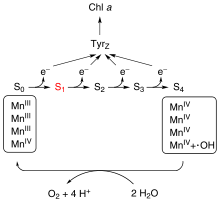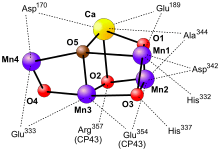Oxygen-evolving complex


The oxygen-evolving complex, (OEC) also known as the water-splitting complex, is a water-oxidizing enzyme involved in the photooxidation of water during the light reactions of photosynthesis. It is surrounded by 4 core proteins of photosystem II at the membrane-lumen interface. Based on a widely accepted theory from 1970 by Kok, the complex can exist in 5 states: S0 to S4. Photons trapped by photosystem II move the system from state S0 to S4. S4 is unstable and reacts with water to produce free oxygen. Currently, the functional mechanism of the complex is not completely understood. Much of the known data have been collected from flash experiments, EPR, and X-ray spectroscopy.[1]
The OEC appears to have a metalloenzyme core containing both manganese and calcium, with the empirical formula for the inorganic core of Mn4Ca1OxCl1–2(HCO3)y. Other characteristics of it have been reviewed; see [2]
It is suggested that the evolution of the OEC was triggered by the presence of the manganese-containing minerals rancieite and hollandite in the early oceans. The minerals were, it is presumed, assimilated by the early Cyanobacteria, which have incorporated them in the active center of the complex.
References
- ↑ Kok, B., B. Forbush, and M. McGloin. 1970. Cooperation of charges in photosynthetic O2 evolution. I. A linear four-step mechanism. Photochem. Photobiol. 11:467–475.
- ↑ Abstract : Manganese: The Oxygen-Evolving Complex & Models1 : Encyclopedia of Inorganic Chemistry : Wiley InterScience
[1] Also see 'Life Ascending' by Nick Lane, Profile Books 2009; pp 83-87, which outlines a possible route for the evolution of the OEC.